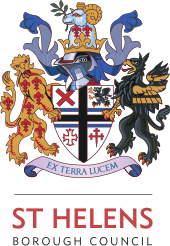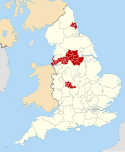St Helens Borough Council | |
|---|---|
 Council logo | |
| Type | |
| Type | |
| Leadership | |
Kath O'Dwyer since March 2020[3] | |
| Structure | |
| Seats | 48 councillors |
 | |
Political groups |
|
Joint committees | Liverpool City Region Combined Authority Merseyside Fire and Rescue Authority Merseyside Police and Crime Panel |
| Elections | |
| Multiple member first-past-the-post | |
Last election | 5 May 2022 |
Next election | 7 May 2026 |
| Meeting place | |
 | |
| Town Hall, Victoria Square, St Helens, WA10 1HP | |
| Website | |
| www | |
St Helens Borough Council, legally St Helens Metropolitan Borough Council, is the local authority of the Metropolitan Borough of St Helens in Merseyside, England. It is a metropolitan borough council and provides the majority of local government services in the borough. The council has been a member of the Liverpool City Region Combined Authority since 2014.
The council has been under Labour majority control since 2010. It is based at St Helens Town Hall.
History
[edit]The first local authority for the town of St Helens was a body of improvement commissioners established in 1845.[4] The town was incorporated to become a municipal borough in 1868, after which it was governed by a body formally called the 'mayor, aldermen and burgesses of the borough of St Helens', generally known as the corporation, town council or borough council.[5]
When elected county councils were established in 1889, St Helens was considered large enough to provide its own county-level services, and so it became a county borough, independent from the new Lancashire County Council, whilst remaining part of the geographical county of Lancashire.[6]
The larger Metropolitan Borough of St Helens and its council were created in 1974 under the Local Government Act 1972 as one of five metropolitan districts within the new metropolitan county of Merseyside. The new district covered the whole area of four former districts and parts of another three, all of which were abolished at the same time:
- Ashton-in-Makerfield Urban District (new parish of Seneley Green only, rest went to Wigan)[7]
- Billinge and Winstanley Urban District (new parish of Billinge Chapel End only, rest went to Wigan)
- Haydock Urban District
- Newton-le-Willows Urban District
- Rainford Urban District
- St Helens County Borough
- Whiston Rural District (parishes of Bold, Eccleston, Rainhill, Windle only)
The first election to the new council was held in 1973. For its first year the council acted as a shadow authority alongside the area's outgoing authorities. The new metropolitan district and its council formally came into being on 1 April 1974, at which point the old districts and their councils were abolished.[8]
The metropolitan district was awarded borough status from its creation, allowing the chair of the council to take the title of mayor, continuing St Helens' series of mayors dating back to 1868.[9] The council styles itself St Helens Borough Council rather than its full formal name of St Helens Metropolitan Borough Council.
From 1974 until 1986 the council was a lower-tier authority, with upper-tier functions provided by Merseyside County Council. The county council was abolished in 1986 and its functions passed to Merseyside's five borough councils, including St Helens, with some services provided through joint committees.[10]
Since 2014 the council has been a member of the Liverpool City Region Combined Authority, which has been led by the directly elected Mayor of the Liverpool City Region since 2017. The combined authority provides strategic leadership and co-ordination for certain functions across the region, but St Helens Borough Council continues to be responsible for most local government functions.[11][12]
Governance
[edit]St Helens Borough Council provides metropolitan borough services. Some strategic functions in the area are provided by the Liverpool City Region Combined Authority; the leader of St Helens Borough Council sits on the combined authority as St Helens' representative.[13] Parts of the borough are covered by civil parishes, which form an additional tier of local government for their areas.[14]
Political control
[edit]The council has been under Labour majority control since 2010.
Political control of the council since the 1974 reforms took effect has been as follows:[15][16]
| Party in control | Years | |
|---|---|---|
| Labour | 1974–2004 | |
| No overall control | 2004–2010 | |
| Labour | 2010–present | |
Leadership
[edit]The role of mayor is largely ceremonial in St Helens, usually being held by a different councillor each year. Political leadership is provided by the leader of the council. The leaders since 1974 have been:[17]
| Councillor | Party | From | To | |
|---|---|---|---|---|
| Len Williams | Labour | 1974 | May 1978 | |
| Gerald Baxter[18] | Labour | May 1978 | 1983 | |
| Brian Green[19][20] | Labour | May 1983 | 1985 | |
| Marie Rimmer[21][22] | Labour | 1985 | 21 Apr 1993 | |
| Dave Watts[23][24] | Labour | May 1993 | May 1997 | |
| Mike Doyle[25][26] | Labour | 1997 | 1999 | |
| Marie Rimmer | Labour | 1999 | 2006 | |
| Brian Spencer | Liberal Democrats | 2006 | 19 May 2010 | |
| Marie Rimmer | Labour | 19 May 2010 | 15 May 2013 | |
| Barrie Grunewald | Labour | 15 May 2013 | 18 Apr 2018 | |
| Derek Long | Labour | 18 Apr 2018 | 22 May 2019 | |
| David Baines | Labour | 22 May 2019 | 15 May 2024 | |
| Anthony Burns | Labour | 15 May 2024 | ||
Composition
[edit]Following the 2022 election, the composition of the council was as follows:[27]
| Party | Councillors | |
|---|---|---|
| Labour | 29 | |
| Independent | 7 | |
| Green | 6 | |
| Liberal Democrats | 4 | |
| Conservative | 2 | |
| Total | 48 | |
In December 2024 Reform UK won a by-election in Blackbrook ward, reducing the number of labour councillors to 28.[28] Of the independent councillors, three sit together as "The Independents" group, two form the "Newton-le-Willows Independents" group and the other two do not belong to any group. The next election is due in 2026.
Elections
[edit]Since the last boundary changes in 2022, 48 councillors have been elected from 18 wards, with elections held every four years.[29]
Premises
[edit]
The council meets and has its customer reception at St Helens Town Hall overlooking Victoria Square in the town centre. The building was built in 1876 for the old borough council.[30] The council's main offices are in the adjoining Wesley House on Corporation Street.[31]
References
[edit]- ^ Dhillon, Aran (16 May 2024). "New mayor of St Helens speaks of her pride". St Helens Star. Retrieved 19 May 2024.
- ^ Dhillon, Aran (15 May 2024). "New St Helens council leader braced for tough job as cabinet unveiled". St Helens Star. Retrieved 5 June 2024.
- ^ "Kath O'Dwyer". The MJ. Retrieved 4 May 2024.
- ^ "St Helens Improvement Act 1845". legislation.gov.uk. The National Archives. Retrieved 5 June 2024.
- ^ A History of the County of Lancaster: Volume 3. London: Victoria County History. 1907. pp. 371–377. Retrieved 5 June 2024.
- ^ "St Helens Municipal Borough / County Borough". A Vision of Britain through Time. GB Historical GIS / University of Portsmouth. Retrieved 28 August 2022.
- ^ "The Local Government (Successor Parishes) Order 1973", legislation.gov.uk, The National Archives, SI 1973/1110, retrieved 5 June 2024
- ^ "Local Government Act 1972: Schedule 1", legislation.gov.uk, The National Archives, 1972 c. 70 (sch. 1), retrieved 30 May 2024
- ^ "District Councils and Boroughs". Parliamentary Debates (Hansard). 28 March 1974. Retrieved 30 May 2024.
- ^ "Local Government Act 1985", legislation.gov.uk, The National Archives, 1985 c. 51, retrieved 5 April 2024
- ^ "The Halton, Knowsley, Liverpool, Sefton, St Helens, Sefton and Wirral Combined Authority Order 2014", legislation.gov.uk, The National Archives, SI 2014/865, retrieved 5 June 2024
- ^ "Understand how your council works". gov.uk. Retrieved 30 May 2024.
- ^ "Committee details". Liverpool City Region Combined Authority. Retrieved 5 June 2024.
- ^ "Election Maps". Ordnance Survey. Retrieved 30 May 2024.
- ^ "Compositions calculator". The Elections Centre. 4 March 2016. Retrieved 10 August 2022.
- ^ "St Helens". BBC News Online. Retrieved 21 February 2015.
- ^ "Council minutes". St Helens Borough Council. Retrieved 28 August 2022.
- ^ "Surprise new team". Liverpool Echo. 10 May 1978. p. 7. Retrieved 28 August 2022.
- ^ "Council chief calls in minders". Liverpool Echo. 26 May 1983. p. 1. Retrieved 28 August 2022.
- ^ "Labour probe to end feud". Liverpool Echo. 13 June 1985. p. 18. Retrieved 28 August 2022.
- ^ "Chief denies Labour rift". Liverpool Echo. 5 July 1985. p. 2. Retrieved 28 August 2022.
- ^ "'Why I had to quit as leader'". Liverpool Echo. 22 April 1993. p. 8. Retrieved 28 August 2022.
- ^ "St Helens bids to lure investors". Liverpool Echo. 17 May 1993. p. 12. Retrieved 28 August 2022.
- ^ "A sober supremo". Liverpool Echo. 2 May 1997. p. 7. Retrieved 28 August 2022.
- ^ "Home help". Liverpool Echo. 17 May 1997. p. 11. Retrieved 28 August 2022.
- ^ "Hundreds mourn Mike Doyle". St Helens Star. 19 January 2009. Retrieved 28 August 2022.
- ^ "Your Councillors". St Helens Borough Council. Retrieved 14 June 2023.
- ^ "Blackbrook by-election result". sthelens.gov.uk. Retrieved 14 December 2024.
- ^ "The St Helens (Electoral Changes) Order 2021", legislation.gov.uk, The National Archives, SI 2021/1424, retrieved 28 August 2022
- ^ "Council committee information". St Helens Borough Council. Retrieved 14 June 2023.
- ^ Mulligan, Simon (28 March 2023). "St Helens Council's customer contact centre to relocate from April". St Helens Star. Retrieved 5 June 2024.
